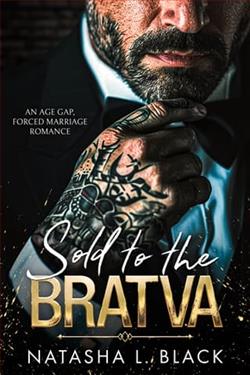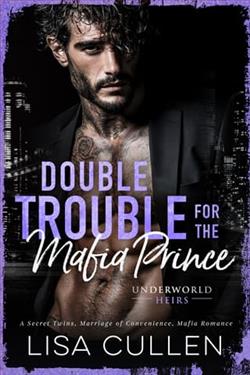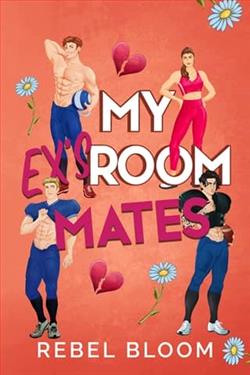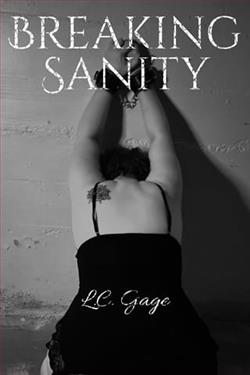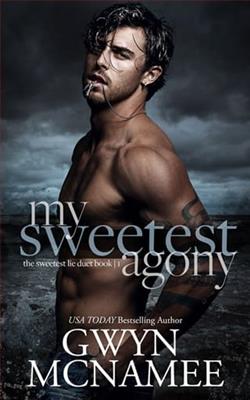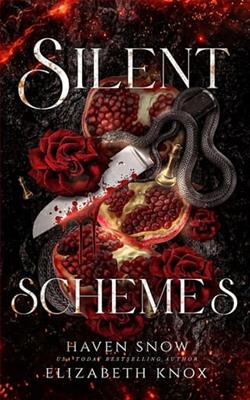Page 44 of Murder on Cold Street
He held his breath, hoping not to see any prints of a lady’s—Mrs. Treadles’s—delicate evening slippers. He didn’t, but he did remark a few dark red drops marking a straight line toward the interior of the house.
Inspector Treadles, passing through?
Holmes crouched down at a spot not too far from the dining table huddle and took out her magnifying glass, which he had given to her a few years ago for her birthday. When he crouched down beside her, she handed him the magnifying glass.
His first glance at the dust sheet did not reveal anything out of the ordinary. Even looking through the magnifying glass yielded no unusual details. It was only by lowering his face nearly to the floor, while making sure he didn’t block any light, that he saw what she wanted him to see.
Several filaments of long, light brown hair, otherwise almost invisible against the dun-colored dust sheet.
Mrs. Treadles had light brown hair.
They exchanged a look as they rose. She took the magnifying glass back from him and went to a spot of what he presumed to be bloodstains. They followed the bloodstains out of the dining room,to the central staircase, where they were met by the sight of bloody boot prints coming down.
He remembered Inspector Treadles’s boots, which had looked as if they’d sloshed through blood.
“It’s a bit like this up to the attic—the blood drops, not so much the boot prints, that is,” called Constable Lamb from above. “Do you want to see the murder scene first?”
At the bedroom two floors up where the murders had taken place, she spent a moment on the door, which still bore signs of having been violently kicked in, before turning her attention to the chalk outlines on the dust sheets.
“Those outlines—do they mark where the victims lay?”
“That’s right, Miss Holmes. Mr. Longstead here and Mr. Sullivan here.”
Mr. Longstead’s outline was closer to the door. A large pool of dried blood stained the dust sheet underneath him. A smaller pool marked where Mr. Sullivan had been shot in the forehead, at the foot of the covered-up bed, his head under a window that looked toward number 31.
A trail of dark red boot prints led to two windows on the far side of the bed, facing the street outside. Inspector Treadles’s blood-soaked soles again came to mind.
“Were you by any chance on the scene yesterday, Constable?”
“Yes, miss. I didn’t discover the bodies but I was among the men brought back from the station by Constable Wells.”
Holmes cradled her chin in the space between the thumb and forefinger of her right hand—her gestures, too, became more numerous, when she was in a mood to encourage the flow of information. “So you saw how they lay, the dead men, before they were moved?”
“Helped move them, too, after the photographer had been.”
She asked Constable Lamb to demonstrate for them how the men lay. He did, stretching himself out on the dust sheets, but not on the outlines themselves, for fear that the blood still hadn’t fully dried.
His imitation of Mr. Longstead in the latter’s final pose had Mr. Longstead lying faceup, one arm stretched out, the other over the wound on his chest. Mr. Sullivan, several feet away, had been more crumpled up, his legs folded, one arm caught under his body, his face almost but not entirely buried in a dust sheet.
“A pocket lantern was sitting nicely right here,” supplied Constable Lamb, patting the sill of the window under which Mr. Sullivan had lain, the one that looked toward number 31.
All this struck Lord Ingram as rather inexplicable. Judging from the way Mr. Longstead had fallen, the killer should have stood facing the door. But if he was to believe the pathologist, then for Mr. Sullivan to have staggered backward and hit the back of his head on the windowsill on his way down, the shot that killed him should have been firedfromthe direction of the door.
If Mr. Longstead had been murdered first, and if Mr. Sullivan had been in the room at the same time, wouldn’t he have run toward the door and been shot in the back, rather than in the forehead?
If Mr. Sullivan had been fired on first, then why had Mr. Longstead subsequently allowed the killer to march straight up to him and place the tip of the gun right against his chest? Or did Mr. Longstead arrive late enough not to witness the death of his nephew?
“Where was Inspector Treadles?” asked Holmes.
The bobby pointed at the windows facing the street. “They said he was crouched behind the bed, with his weapon drawn and aimed at the constables.”
Holmes went around the bed and lifted the sash of one of those windows. Her hands on the sill, she leaned out for a look.
“You are a little more agile than me, my lord,” she said, yielding her place. “Do you think you could have left the house via this window?”
They were three floors up, but the house had an ornate façade; below and above the windows protruded architraves that wended along the length of the entire row.
Without too much difficulty, he could hang on to the architrave just outside this window and drop himself onto the small balcony one floor below. From there, to reach the pavement walkway, he would need to leap clear of the fenced area in front of the house, which enclosed the descent to the basement service entrance. But that would not have posed too great a challenge.









